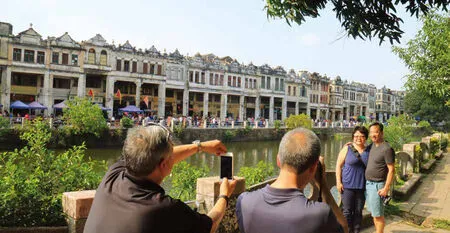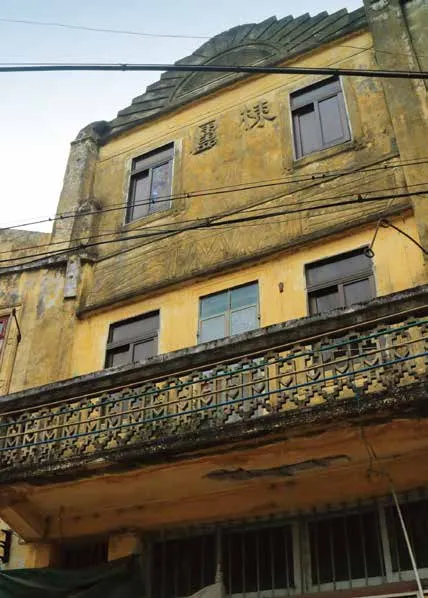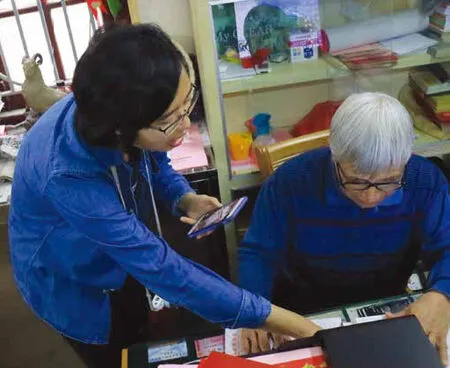ROOTS AND REMEMBRANCE
TEXT AND PHOTOGRAPHY BY HATTY LIU
ROOTS AND REMEMBRANCE
TEXT AND PHOTOGRAPHY BY HATTY LIU
Genealogy tourism grows as overseas Chinese seek clues to their identity
海外华人的岭南寻根之旅

Thirty years later, Huiying Bernice Chan, a New York anthropologist of overseas Chinese communities, arrives at her grandmother’s old home the day after the Qingming (“Tomb Sweeping”) festival. After seeing Chan’s photos proving her relation to the former neighbors, Situ’s wife fishes a key from a drawer. Situ himself arrives a few minutes later, beaming.
“Sure, I remember the grandmother,” he says as unlocking the door. “I remember all the family. I was very small, but I lived right here. They went to America, didn’t they? It was a very long time ago.”
Kaiping, where Chikan is located, is part of a regionknown as the Five Counties (五邑) in Guangdong province, about 100 kilometers southwest of the metropolises of Shenzhen and Guangzhou. Together, the counties make up one of the biggest of what’s known as theqiaoxiang(侨乡, or “overseas homeland”) in China. These communities are dotted across China’s southeast coast, from Fujian down to Guangdong’s Teochew region, the booming Pearl River Delta, then westward as far as Zhanjiang near the island of Hainan. Starting from the mid-19th century, poverty and war forced these communities to look to the sea for survival. Young men set out to work in Hong Kong, Southeast Asia, the Americas, and Australia, sending their earnings home, eventually calling for their families to join them abroad.
In many ways, however, the identity ofqiaoxianghas less to do with who left, as who comes back. The countryside around Kaiping is dotted withdiaolou(碉楼), colonialstyle watchtowers, UNESCO World Heritage sites that featured in 2010 action-comedyLet the Bullets Fly, filmed just off Chikan’s main street.
Fusing Chinese and European architecture, these fortress-likediaolouwere built by those who wanted to use wealth accumulated overseas to protect their family’s property from bandits. Local schools, parks, hospitals, even a farm bear the characters for “overseas Chinese”(华侨) rather than the usual “people’s”(人民); some were built decades ago but most are sponsored by diaspora groups, who make return visits for ribbon-cutting ceremonies and the occasional Spring Festival. And in almost every village in the Five Counties, there are families like the Situs, who preserve stories, memories, and sometimes a physical home to show descendants of overseas Chinese should they ever come looking.
“It was incredible; I was always under the impression that we had lost contact,” Chan says after visiting one of her ancestral villages. “But they were very up-to-date with information about my family, they knew about who passed away, and how. That’s what amazed me—the bond that’s kept between villages around the world.”
Both sides of Chan’s parents and grandparents had emigrated in the 1980s, but it was not until she went to her grandfather’s village that she found out her great-grandfather had also been an émigré. “One of the elderly neighbors unlocked the house, and there was a dresser with scattered papers…in it was a letter my greatgrandfather wrote to my grandfather from New York City, and that’s how I found out he’d gone there. I found his Brooklyn address, and I found out he worked in the laundries there; he wrote that it was very hard and that his bones were tired.”
In Chinese the most common words for these kind of journeys are 寻根 (“root-seeking”), 寻亲 (“relativeseeking”), or 返乡 (“returning to the home village”); none quite tell the full story. Overseas Chinese may simply be curious to see a place they’ve heard often mentioned, without being sure there are records or relatives left to find. Most don’t intend to “return”permanently, and many don’t linger in the ancestral village itself more than the time it takes to snap some photos.
首先确定全自动钢印打印所需运动方式,即证件必须正确堆放在固定区域,由抓手抓住证件,而后将证件准确送到钢印机打印位置,完成后打印后退回原位,抓手将证件通过另一方向移动将证件移至证件摆放区,松开抓手,抓手原位返回继续抓住第2个证件,重复上述动作,最终

This picturesque waterfront of Chikan is a popular stop on the itinerary of overseas returnees
Perhaps this is why the Chinese terms are often paired with 旅, denoting travel or tourism, as in 寻根之旅 (“root-seeking travel”), while in English, these journeys are sometimes referred to as “genealogy trips” or“ancestor searches,” conjuring up images of poring over genealogy databases so that one can claim descent from Charlemagne at a dinner party. In an email, Huihan Lie, the Dutch-Chinese founder of My China Roots, a Beijing-based agency that helps overseas Chinese find their ancestry, once refers these trips as “pilgrimages,” but even that can’t capture the experience of visiting one’s ancestral village. Though sometimes a trip brings pilgrims closer to their roots, the start of the journey is more like a detective story.
Liang Yanjun, deputy director of the state-run Kaiping Overseas Chinese Association, seems puzzled by the need for private organization like My China Roots. “Overseas Chinese can just contact us, give us their surname, the name of their village, and we’ll contact our liaison there and arrange a visit,” she says.
As straightforward as this seems, there are obstacles. One would need to know enough about China and the Five Counties to be aware of organizations like Liang’s; language skills in both Mandarin or a local dialect are vital as well, as websites are only in Chinese and few staff speak other languages.
Unlike Chan, who arrived with the names of all four grandparents’villages in a notebook and was fortunate to find neighbors who’d kept in touch, most “roots-seekers” have far rockier starts.
“The spelling of place names in English didn’t used to bestandardized, and oftentimes that’s all that [clients] have,”says Helen Lam, a Hong Kongbased project manager with My China Roots, who describes a typical scrap of evidence as “their grandfather’s head tax form with the village name on it, [transliterated] from Cantonese.”1
Lam does archival research and occasionally takes clients to villages on the mainland.“Often, the immigration official wrote whatever they thought they heard. Or they’d just write‘Canton.’” Surnames aren’t foolproof, either; apart from inconsistent spellings, immigrants sometimes changed their names to pose as“paper sons” to families that had already settled abroad, and avoid the exclusionist laws of countries like the United States and Canada.
Generally, says Lam,the earlier the family emigrated, the more challenging the search becomes. There may also be challenges when the client is an adoptee, mixed-heritage, or several generations removed. “In those cases we just ask the client to find whatever information they can—names, old documents, where they landed—and our researchers start with those,”Lie explains.

The staff of the Guan clan library assist overseas returnees to locate their family branch and village name
WITH SO MANY OBSTACLES, FOR MANY DESCENDANTS THE START OF THE JOURNEY IS LIKE A DETECTIVE STORY
1Introduced in 1885, the head tax targeted Chinese immigrants entering Canada with a 50 CAD levy (later raised to 100, then 500)

The house where members of Chan's extended family return to pay their respects during Qingming
WHEN ALL THE PIECES FALL IN PLACE, WHETHER THROUGH LUCK OR PERSEVERANCE, THE EXPERIENCE IS“MIRACULOUS”
In other cases the descendants may not know anything, other than that relatives were once Chinese. Two sisters, Eunice and Jing Yi Beh, thirdgeneration Malaysian-Chinese, tell TWOC that their grandfather never shared any details about his former life, possibly due to painful experiences. The only clue was the name of a village engraved on his tomb, a Chinese burial custom for those who’ve died overseas.
Arriving in Yangkeng village in Puning, Guangdong, the Beh family found that there was no one left who could recall anything about their branch of the family. Even being shown the village’s copy of their clan’s genealogical records, orzupu(族谱), proved to be disappointing, as it only went up to the generation before their great-grandfather’s.
“So we just saw our clan’s ancestral temple, and asked the village official to spread the word on WeChat that we were looking [for relatives]; he hasn’t heard from anyone yet,” Jing Yi Beh says, a year later. “Instead, I’ve found all of his relatives that he asked me to look up in Malaysia.” The only thing the family could do was sample the local food, says Beh; that, at least, tasted like home.
A best-case scenario is documented inAll Our Father’s Relations, a Canadian documentary that had its overseas premiere at the Beijing International Film Festival in April. In it, four siblings of the mixed-race Grant family visit their father’s home village near Zhongshan in 2013. The Grants discover an uncle they never knew about, meet the daughter left behind by another uncle who’d immigrated to Canada, and are shown pictures of their ancestors decorating the walls of their great-grandfather’s house. “I was told, ‘You are the 17th generation of this house,’” Larry Grant told the Vancouver Courier afterwards. “‘Oh my God.’ That was my reaction.”
“Every person in the world, ofany ethnicity, any skin color, has some yearning to know where they come from,” says Yang Shereng, a researcher affiliated with the overseas association in Toisan (Taishan, 台山), another of the Five Counties. Yang has had clients who’ve searched fruitlessly for 10 years, armed with just family lore that “the village their great-grandfather left 200 years ago had a well in front of an ancestral temple in front of a hill.” Other clients arrive with detailed information, only to find the ancestral home razed, the victim of either natural disaster or urban development. “Not everyone is lucky enough to find relatives,” Yang says.“It has been too many years, lots of villagers have migrated, and older people who had memories of their family have passed away.”

Chan and a genealogist of the Guan clan association pore over the new names they are adding to the family tree
But when all the pieces fall in place, whether through luck or perseverance, the experience is “miraculous,”says Yang. “Two years ago I had an American client. We were walking around a village for two hours, it was pouring down rain. Then an old man passes by on a bike. ‘Maybe you’re from our parts,’ he said to us,” Yang recalls. The old man took them to his own house. “There’s an altar on the wall with about a dozen ancestral tablets, and he climbs a ladder and takes one down. It was caked with dust, but he wipes it off, and on that gloomy day, it just seemed to glow. It was [the client’s] ancestor’s name. That young man…tears were just streaming, and he kept saying it was destiny.”
Not every trip home carries the same emotional heft. “Growing up, my parents always gave the impression that they were glad to have left, so there wasn’t a longing feeling. I wasn’t interested in coming when I was younger,” admits Grace Lowe of Victoria, British Columbia. Lowe made the trip to Chikan with her husband and a number of Canadian friends, all with roots in Guangdong.“I just wanted to find any sign that my family was here,” she says. Village elders led Lowe to a house belonging to her grandmother. More than 20 years after Lowe’s last relative had left, the building was still immaculate, cleaned and cared for by two women in their 80s.
“Of course we have to look after it for them,” says the son of one, surnamed Chen. His family lives next to the Lowe’s family home and, like most in the village, they are distantly related. “We’re a big family; so we help them take care of it when they’re away.”
He takes it for granted that the family never left permanently—and that, according to Chan, is an irresistible idea to many in the Chinese diaspora. To anyone who has ever felt alienated or torn in what Chan calls“the in-between space” of a diasporic identity, the idea that there’s a family record waiting for you in China, or neighbors who literally hold the keys to your past, is an enticing prospect.
Having visited her family home, Chan is now hoping to locate all four grandparents’zupuand trace their history back 100 generations. In Chikan, she visits the library of the Guan clan association, where the genealogists are working on a family tree of the male members of her grandmother’s clan. As the elderly researcher flips through the thick tome, fathoming a path through the sprawling lines and unmarked pages, there’s a moment of recognition. “My family,” Chan points suddenly at a page.
A moment later, she has her own notebook open to a page with the names of current relatives, which the researcher is adding to the ancient tree, pencilling new names in margins and leaves that have been waiting for them all along.

